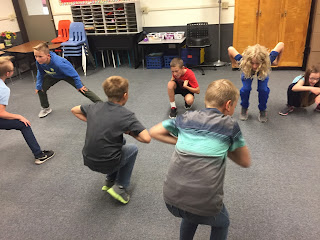Then we pulled out pieces of paper from two bowls, one containing the locomotor steps, and the other with energy qualities. The students had so much fun pulling out a piece of paper from each bowl and having to create that movement. In fifth grade we experimented how different adjectives might affect our movement. We played a game where two students would be given an adjective to perform their energy quality and locomotor movement in, and the others had to guess what adjective they were assigned. We could have played this game all class period!
Next, we read the Korean myth "The Ungrateful Tiger" and did specific movement for each of the characters found within the myth. After performing this small dance, we decided to change some aspects of the myth. For example, what if the ox in the myth had long, skinny legs instead of short, strong legs? What if the hare could not pick up its feet when it moved? What if the trees could see? We went through the poem like this and changed different aspects to show that if we have a creative imagination, anything can be within reach.
The students then split into groups where they pulled pieces of paper from the bowls and choreographed a dance using the movement they selected from the bowls. It was great to see the creativity of the students and how they combined the dance energy qualities with the locomotor movement. Then we were able to talk about all the different things we are capable of doing, and everything that is within our reach. We were also able to pick out the main theme, or lesson found within the myth.
These students blow me away with their creativity each week. I learn so much watching them create movement and choreograph with their classmates.
Students percussively walking through the room. One student helps another jump while collapsing.
Students work together to create movement.











